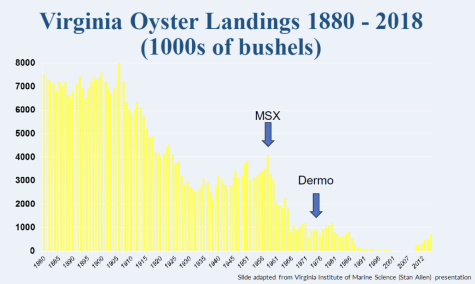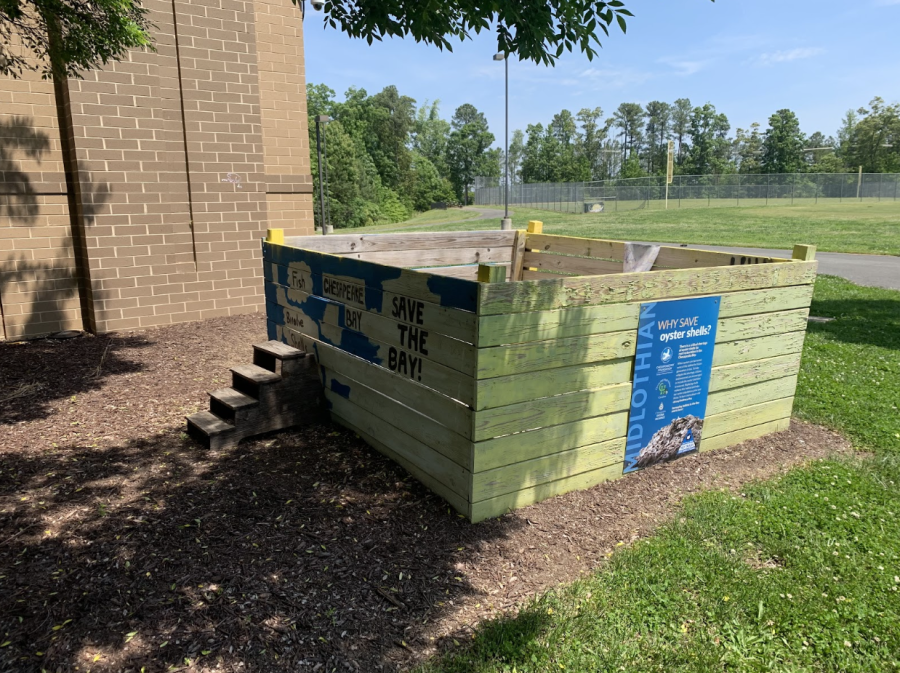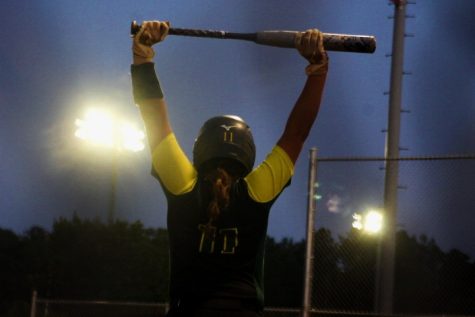How Clover Hill’s oyster shell recycling bin can help restore the Chesapeake Bay
Clover Hill’s oyster shell collection bin stands ready for donations outside the building.
Clover Hill High School is one of only 23 drop-off and collection sites for the Chesapeake Bay Foundation’s (CBF) oyster shell recycling program across Virginia, and it is the only site in Chesterfield County.
As part of the program, Clover Hill added an oyster shell collection bin to the campus; it is located behind the school in the courtyard area directly outside the cafeteria where students are permitted to eat lunch on warm days.
According to CBF oyster restoration specialist Julie Luecke, the purpose of the program is to restore the reefs in the Chesapeake Bay by providing young oysters with a healthy and suitable habitat.
“Oyster shells are literally the foundation of our reef restoration efforts, but they are becoming increasingly scarce,” Luecke said. “When oyster larvae are about two to three weeks old, they must attach to something hard. Oyster shells make the best habitat for young oysters, which is how reefs are formed. We turn 2000 bushels of recycled oyster shells each year into habitat for millions of oysters planted in the Bay and its rivers.”
To do this, CBF collects the oysters from the recycling bins before cleaning them and providing them to oyster larvae as habitat. The shells are then ready to return to the Chesapeake Bay where the oysters they provide a home for revitalize the Bay.
“Once the recycled shells are cleaned and cured, CBF places them in huge water tanks containing millions of microscopic oyster larvae, which then attach to the shells,” Luecke said. “On average, each recycled shell can become home to ten of those baby oysters, called spat. CBF provides the spat-on-shell to its oyster gardeners and plants them in rivers and the Bay to grow and expand oyster reefs.”
This strategy to restore the Bay and its oyster reefs worked in the past; Luecke believes that the reversal of oyster population trends in Bay in the 1930’s provides evidence that returning oyster shells to the Bay is vitally important to keeping it healthy.
“[In the 1930’s] oyster populations went from decreasing to increasing,” Luecke said. “Around this time, shucking houses in Virginia had piles and piles of shucked oyster shells just sitting and taking up space. To free up that space, some shucking houses simply pushed the shells back into the water. You can see in the graph [of Virginia oyster populations over time] that it made an immediate difference in oyster populations.”

According to Luecke, the work of the oyster restoration program is essential because oyster populations in the Chesapeake Bay have declined substantially over time due to over-harvesting, disease, pollution, habitat loss and other human-caused environmental changes. When CBF began their oyster restoration in the 1990’s, they faced an oyster population that had declined overall for around 80 years.
“In the 1990’s, when the oyster harvest was so small it was negligible, CBF started our oyster shell recycling program,” Luecke said.
This decline is part of an international trend of size reduction of oyster reefs. A 2011 study conducted by an international team of scientists, including Mark Luckenbach of the Virginia Institute of Marine Science, estimated that 85 percent of global oyster reefs are lost.
According to CBF, this decline is a problem because oysters are an important keystone species in the Chesapeake Bay, which includes parts of six states: Virginia, Maryland, Delaware, West Virginia, New York and Pennsylvania as well as the District of Columbia. 18 million people live in the Chesapeake Bay watershed, and the Bay provides food and recreation to the people that live there. As the largest estuary in the United States, the Chesapeake Bay is important to the environment and its health has consequences for the entire Earth system.
Oysters and their shells are essential to keeping the Bay healthy, because they improve water quality by filtering out sediments and algae and provide habitat for other organisms in the Bay, among other environmental functions. Because of this, the decline in their population resulted in a coinciding decrease in the health of the Chesapeake Bay as a whole. Therefore, CBF is committed to restoring them in the Bay to both maintain the Bay’s health and keep Virginia’s oyster industry, one of its largest, thriving in the years to come.
To help the CBF accomplish this goal and provide local residents and restaurants with a place to dispose of their used oyster shells, Clover Hill worked with CBF to host an oyster shell recycling bin. According to Lueke, Clover Hill’s bin, which began operation only a few years ago, has not yet provided many shells.
“Clover Hill is actually our newest shell bin, and it was installed shortly before the pandemic, so it has not collected very much shell at all,” Luecke said. “Many restaurants, about half of our participating restaurants, stopped collecting shells during the pandemic and are just now beginning to save their shells again.”
According to environmental science teacher Michelle Huber, several restaurants have made donations to the bin in recent years.

“We’ve had some use of it [so far],” Huber said. “We’ve had some restaurants notice and deposit their shells, and some citizens [have dropped off shells as well].”
However, CBF has not yet collected any shells from Clover Hill due to the bin receiving only a small amount so far. So, there is still work for Clover Hill and Chesterfield County to do before the recycling bin contributes to oyster restoration efforts.
“[CBF] will wait until it gets a little bit more full [to pick up the shells],” Huber said.
Students such as the environmental club have already tried to spread awareness about the bin and worked to maintain and improve it, providing an example of how the school could increase the number of donations in the future.
The efforts of CBF and the oyster shell recycling collection sites, including Clover Hill, have led to a change in the trend of oyster populations in the Bay. According to Luecke, oyster populations have increased since the start of the restoration program.
“While this [program] is only one of the factors that have led to increased oyster populations in the last 20 years, it is an important one,” Luecke said. “Other factors include better fishery management and the growth of aquaculture.”
In the future, Luecke would like to work with more restaurants to increase the number of recycled shells in the oyster restoration program.
“We are always trying to increase the number of restaurants recycling their shells in Virginia,” Luecke said. “One way we are trying to do that right now is providing an incentive; CBF proposed a bill to this year’s Virginia General Assembly that would provide a tax credit to restaurants that recycle their shells. Hopefully this will be a tool for us to recruit restaurants more easily , since it is beneficial to them as well as to the Bay.”
These bills, S.B. 997 and H.B. 1438, passed and are enacted into Virginia law. The new law is set to go into effect on July 1.
Students can help with this issue on a local level by convincing more restaurants to donate to the program or volunteering to transport oysters from local restaurants to the Clover Hill collection bin. However, increasing the number of restaurants is just one of the ways Luecke believes students can make an impact.
“[Students and Chesterfield community members] can help by contacting CBF if they are planning an oyster roast or seafood festival, sponsoring a shell recycling bin like Clover Hill’s at their location, disposing of their shells at a local shell recycling location like Clover Hill, eating at a participating restaurant and becoming a Virginia oyster gardener.
Anyone interested in volunteering should contact Luecke at [email protected] or reach out to CBF or a local restaurant or oyster roast. Volunteers help CBF and the Chesapeake Oyster Alliance, a group of environmental organizations who do oyster restoration, achieve their goal of adding 10 billion oysters to the Bay by 2025.
Though it may be just one bin that has only operated for a few years, Luecke believes that the students and staff of Clover Hill, with the help of the Chesterfield County community, can become an important part of oyster restoration in Virginia and turn the bin into a productive shell collection site in the future.
“With the help of the students and teachers at Clover Hill, I know that we can grow the shell recycling program locally,” Luecke said.

Ben is a senior in his third year of writing for the Cavalier Chronicle and his second as an editor. His love for writing led him to join the staff, and...







